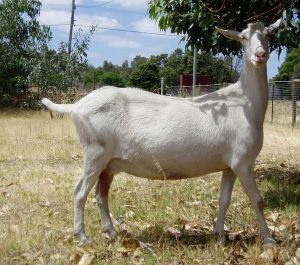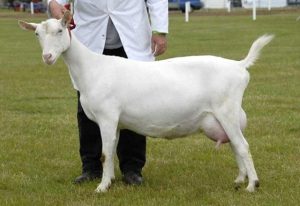Saanen
The Saanen goat originated from Saanen Valley of Switzerland. They are the largest among all the dairy goat breeds. They are mainly raised for commercial milk production like jamunapari and alpine goat. A female Saanen goat produces about 3.8 liters milk daily.
Nowadays, Saanen goats are being raised throughout the world.
Characteristics :
- Mainly Saanen goats are of white colored. But sometimes biscuit colored goats can be seen.
- There may some black spots in the nose, ears and udder of this goat.
- The ears are straight to upwards.
- Generally they have no horns.
- Small sized legs.
- Udder become very big sized.
- Long sized neck.
- Their whole body is covered with small sized hair.
- The produces milk highly among all the dairy goat breeds.
- They can adopt themselves with the weather of any region of the world.
- They love to stay under shade and can’t tolerate sunlight highly.
- An adult male Saanen goat weights about 70-90 kg and an adult female goat weights about 60-70 kg.
- On an average a female goat produces about 3.8 liters milk daily.
- Their milk contain about 3.5% fat. And this milk is very suitable for preparing all types of dairy or milk products.
Feeding
As Saanen goats are highly milk productive so, they need some extra protein and energy with their regular feed. Along with fresh and good food always provide them fresh and clean water regularly.
Breeding
Saanen goats typically breed every year. And each time produce one or a pair of kids. Take extra care of breeding bucks and pregnant does.
Housing
Housing is very important for Saanen goats. Because they love to stay in shady place and can’t tolerate heavy sunlight. A good house also protects them from all types of predators, adverse conditions and all types of diseases.
Saanen Goat Care
It is very easy to raise Saanen goat. They don’t need any special and extra care. You can raise them with your other animal easily. Even a child can raise and take care of them easily. But taking some extra care and management will increase their health and production.


